Mylnyanka

Mylnyanka, scientific name - saponaria, refers to annual, biennial and perennial plants. The name saponaria is derived from the presence of saponin in the roots, and therefore the plant was used in ancient times as a good cleansing soap.
In addition, soapwort is used in the food industry, folk medicine, cosmetology and landscape design.
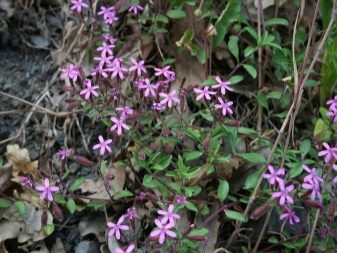
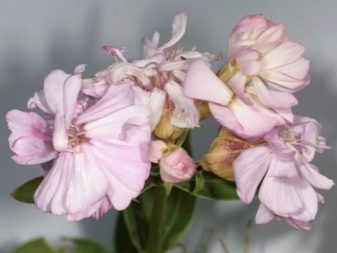
Description and habitat
About 15 species of soapwort are known, whose habitat is Eurasia. In Russia, about 10 species grow, in the middle lane in the wild, only one species grows: Saponaria officinalis, medicinal soapwort. This tall (30–100 cm) perennial is found on the banks of rivers and lakes, has a large, horizontally located root system of a reddish-brown hue.
Uses of the culture:
- manufacturing of medicines for humans and animals;
- in everyday life for removing stains and as a detergent;
- in the food industry, as one of the ingredients for the manufacture of oriental sweets;
- as one of the components in the production of natural cosmetics made using organic and plant substances.
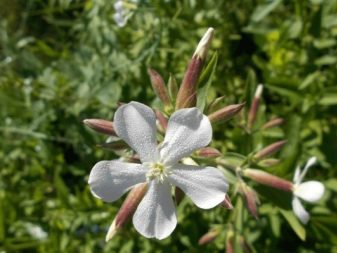
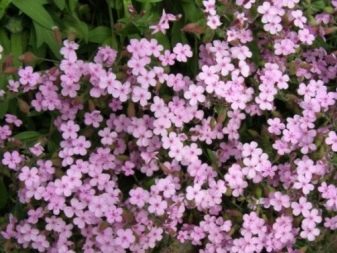
Not wide (1–4 cm) opposite lanceolate leaves 5 to 12 centimeters long have three longitudinal veins, the surface of the leaf plate is smooth or slightly pubescent, the upper leaves are sessile, the lower ones are attached to shortened petioles.
As for medicinal soapwort, it contains a large amount of vitamins and useful organic compounds. It has long been customary among the people to prepare infusions and decoctions from it. They were taken as a remedy for the treatment of the gastrointestinal tract, lung diseases, as an anti-inflammatory and expectorant, diaphoretic, laxative and antihelminthic agent. As an external remedy for the treatment of dermatitis, lichen and eczema, they make gruel from leaves and roots.
However, it should always be remembered that treatment with folk remedies, including soapworms, requires specific knowledge - the plant is poisonous and independent production of the remedy can lead to poisoning. Before embarking on self-medication, you should visit your doctor for advice.
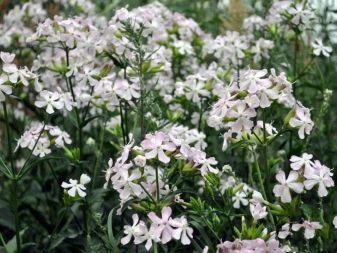
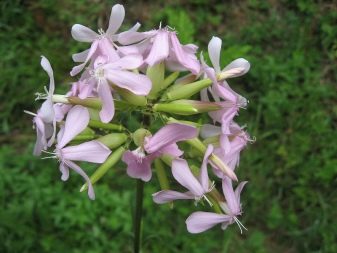
Saponaria ocymoides is used as an ornamental species. The ground cover does not exceed 10-15 cm, and its raised, highly branched and knotty shoots are crowned with small-medium, no more than 1-5 cm in diameter, flowers with red-pink hues and a pleasant aroma. Inflorescences are multiflorous, corymbose-paniculate, located on shortened pedicels, and the bracts have a linear-lanceolate shape.
The calyx of the flower has a five-toothed tubular-cylindrical shape, the length of which varies from 1.5 to 1.8 cm. The corolla consists of five separate petals, longer than the calyx itself, ten stamens and a pistil with two filiform columns. The main color is white with pink shades, from rich to pale tones, however, there are also darker varieties. The stems can be either smooth or rather rough, covered with sparse and rough pubescence.
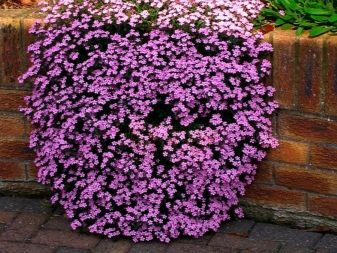
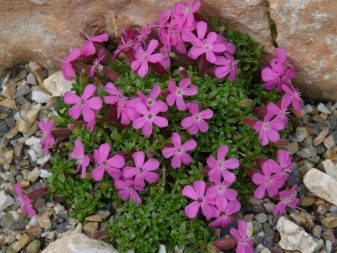
The fruit of the soapwort looks like an oblong ovoid capsule with one nest. It opens in the apical part with four folding teeth. Inside there are numerous small warty, spherical-kidney-shaped seeds of black color. They reach maturity in September.The culture belonging to the clove family is propagated by seed, cuttings (terry varieties) and dividing the bush. Flower formula - K (5) C (5) A (5 + 5) G (2).
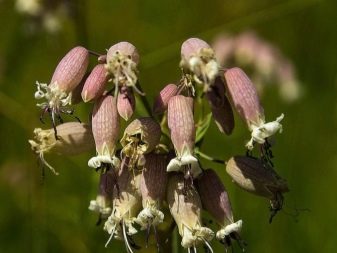
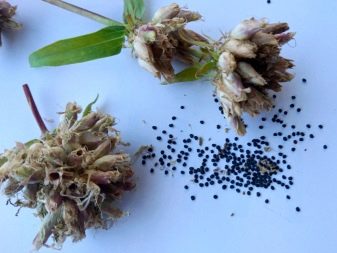
Types and varieties
The beginning of breeding work with wild soapwort falls on the end of the 17th century, after which it was used to decorate garden areas as an ornamental ground cover. A characteristic feature of the garden soapstone is the richness of halftones, from white to dark pink, almost red, between which there are purple, cream and powdery halftones. All this miniature splendor flaunts against the backdrop of bright green foliage. Among modern garden varieties, there are also terry varieties, which can only be propagated vegetatively, but the offspring fully retain their parental qualities.
- "Basilikolistnaya". An abundantly flowering perennial, known as a wild plant, whose habitat is in the Alpine foothills and highlands. Creeping shoots form a low (up to 15 cm) thick pillow. Reddish and deep pink fragrant umbellate inflorescences rest on dull green foliage with lanceolate outlines.
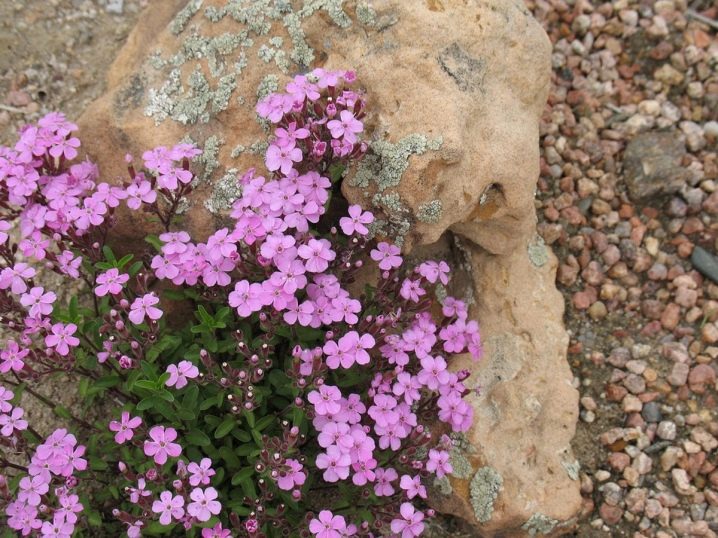
- "Inspiration". An ornamental ground cover, whose shoots form a dense cushion up to 0.3 m tall. White or light pink soapwort blooms in mid-summer, fragrant inflorescences are located above oval-pointed leaves of dark green shades.
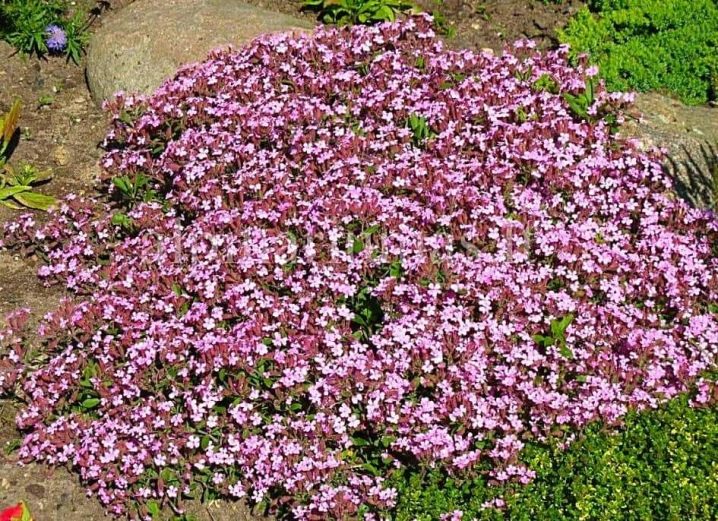
- Camilla. The height of the undersized saponaria does not exceed 15 cm, has a lanceolate dark emerald slightly pubescent foliage, the inflorescences consist of miniature pink flowers.
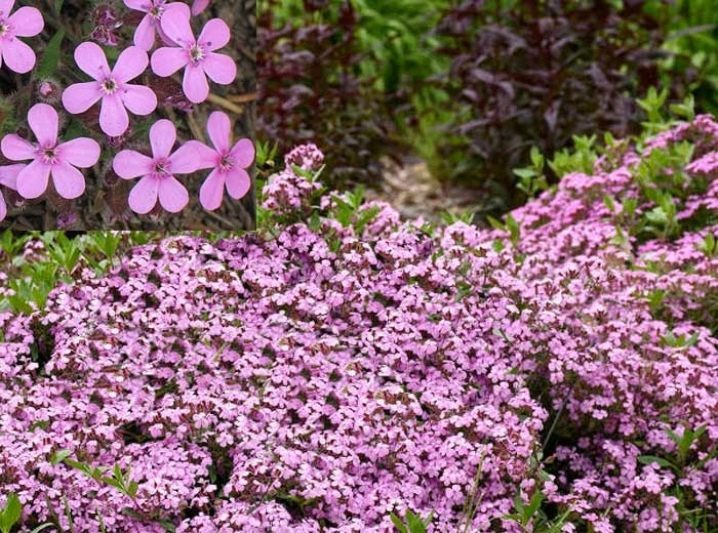
- Moon Dust. Its wildlife habitat is also in the Alpine Mountains. This is a ground cover perennial, decorated during the flowering period with an abundant head of dark pink fragrant inflorescences. The height of the curtain is 20 cm, the leaf has an elliptical outline and a dark emerald color.
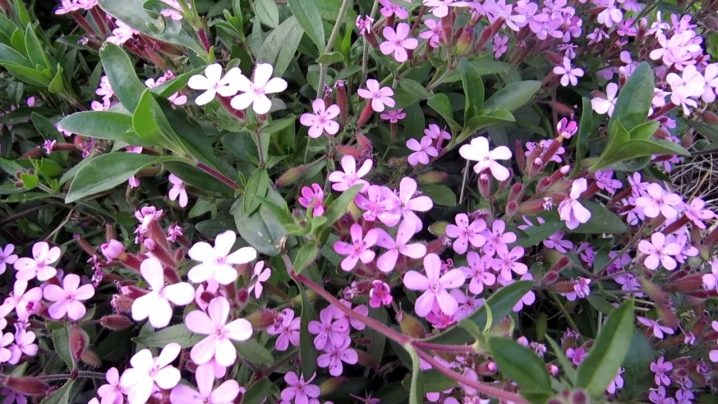
- Olivana. A garden variety bred by crossing sod and dwarf varieties. It has a flat cushion shape, dark green foliage and fragrant pink inflorescences. The height of the ground cover does not exceed 5 cm, the width is 20 centimeters.
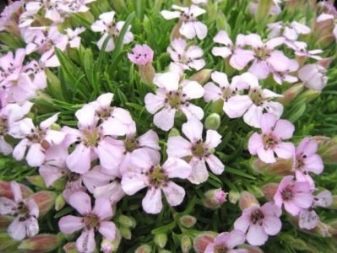
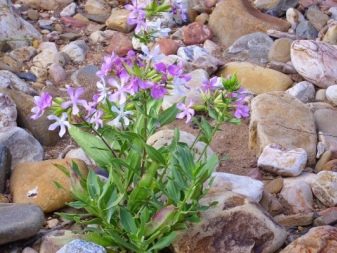
- "Common soap". The habitat in the wild: Europe, Asia, Siberia, the Caucasus. The plant is tall (0.9 m), fragrant inflorescences are painted in a pure white or pink palette, foliage is in dark green tones.
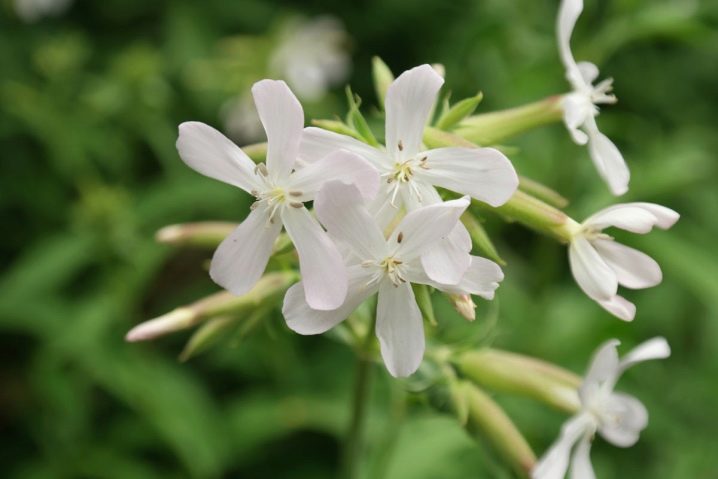
- Bressingham. The height of the ground cover does not exceed 40 centimeters, the bushes form dense cushions of a gray-green hue, abundantly covered with dark pink umbrella inflorescences during flowering. The pleasant aroma contains sweetish notes. Long flowering - throughout the summer.

- Rosea Plena. This variety is distinguished by long and abundant flowering, at this time the 50-centimeter curtain is completely hidden by a cap of fragrant terry inflorescences with a rich palette of white-pink shades, up to a rich raspberry color.
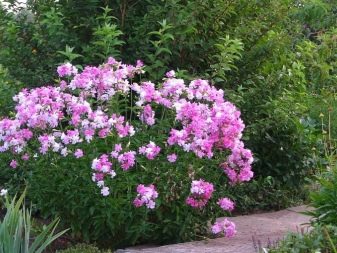
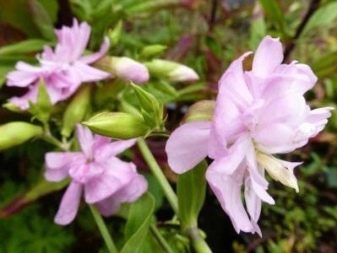
- "Soapy ground cover". The birthplace of the plant is the Iberian Peninsula. Shrub height - 15 cm, lanceolate foliage of dark green color has a strong gloss, inflorescences - light pink shades, a pleasant aroma. Flowering begins in mid-summer.
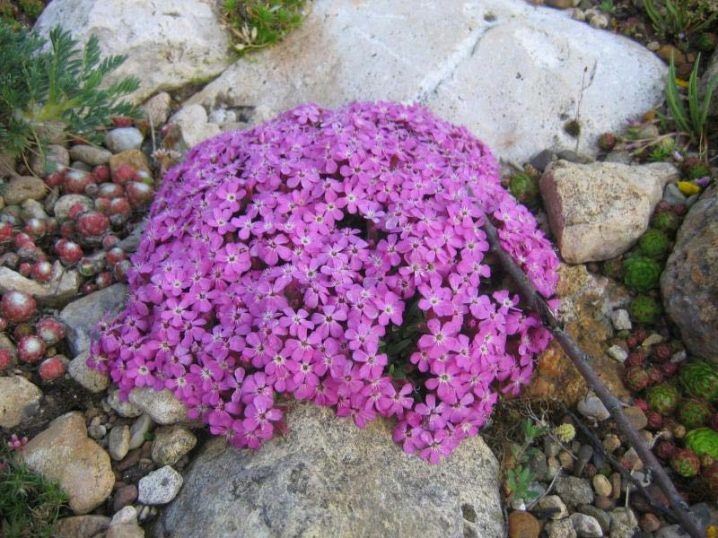
- "Pink Lawn". Abundantly flowering herbaceous bush 20 centimeters with long semi-creeping shoots. Narrow green leaves have a characteristic oval shape, umbellate inflorescences are covered with pink-red medium-sized flowers.
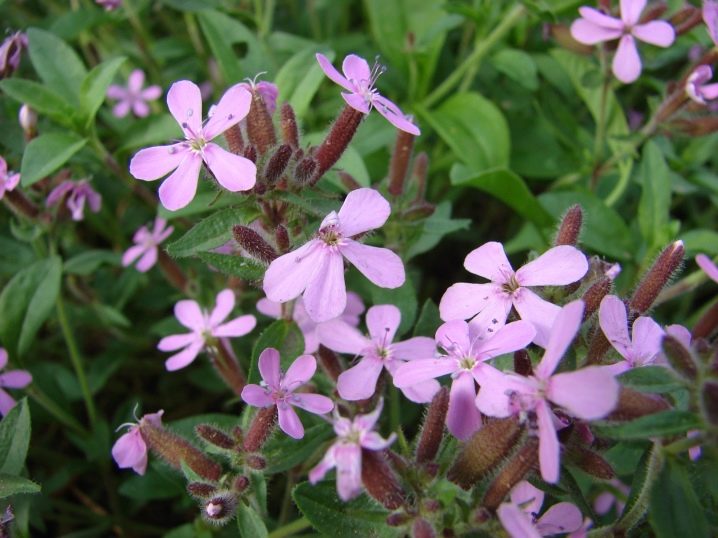
- "Pumila". Shrub 40 centimeters high is covered with dark green elliptical foliage and rich purple-burgundy flowers, collected in umbellate inflorescences. The duration of flowering allows you to decorate the surrounding space with fragrant inflorescences throughout the summer season.
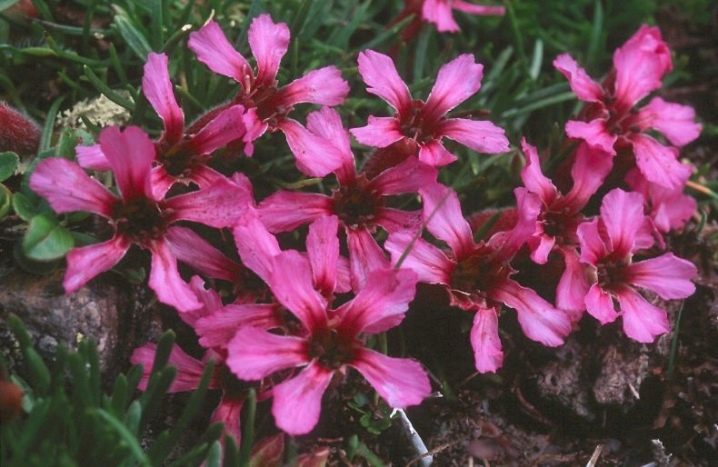
- "Perennial soapy". The shrub is not as decorative as the previous relative, but it is able to play the role of a soloist in a rock garden, since its height reaches 1 meter, or with its help you can create separate compositional groups.The dark green foliage has an oblong shape, the umbrella inflorescences are white and pink. The variety blooms in the middle of the summer season, the flowers have a characteristic pleasant aroma.
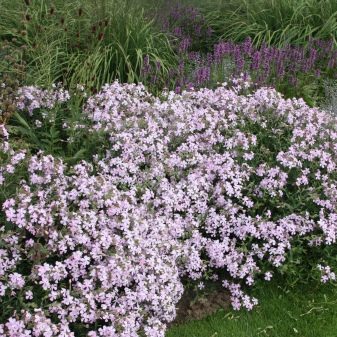
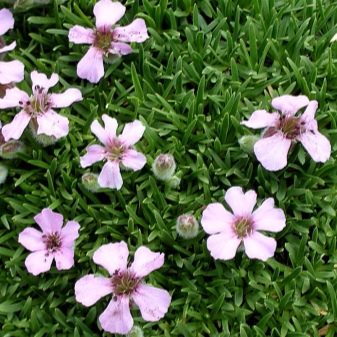
The plant is ideal for creating alpine slides, decorating unoccupied voids, and its root and upper part can be used in everyday life.
Landing
For saponaria, the natural habitat is depleted stony soils, which led to its ground cover. There are, of course, exceptions, for example, perennial soapwort, whose height reaches 1 meter. Basically, these are ground cover varieties. For soapworms, a factor such as the amount of sunlight is extremely important. The more intense the lighting, the richer the shades, and vice versa, poor light makes the palette faded and muted. Penumbra is possible for full-fledged cultivation, but more effort will have to be made for the soapwort to develop in full force. This feature of plants should be taken into account when planning landscaping.
Spartan conditions in nature exclude fertile soils at the planting site. The most optimal will be a soil with a high calcium content, a small amount of nitrogen and an obligatory drainage layer so that after watering the moisture does not stagnate in the roots. Usually, the soil is limed and mulching is used, using crushed stone, expanded clay or fine gravel for this.
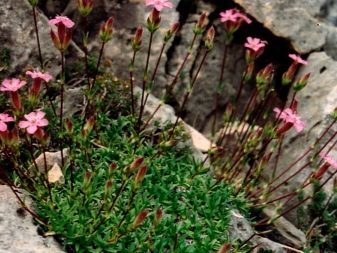

This approach allows you to decorate free space and give an original appearance to the site.
- To plant a soapstone on your own plot, use a method of growing from seeds or a seedling method, planting cuttings obtained from a mother bush or rooted cuttings. Seeds require stratification, so they must be sown in late autumn or early spring, but the germination rate is extremely low, so gardeners prefer the seedling method.
- Sowing for seedlings is carried out in mid-March. in small greenhouses with daily ventilation and humidification, and do not confuse watering with humidification. It should be remembered that air humidity is much more important for tender seedlings than watering. It is enough to moisten the earth and water it only when it is clearly drying out, but spraying is carried out daily.
- The grown seedlings are transferred to open ground after the season of return frosts. The optimal distance between the bushes is 30 cm.
After planting, delicate plants are watered and protected from the scorching sun rays. This role is perfectly fulfilled by plastic mesh boxes for fruits and vegetables. In the first one and a half to two weeks of planting, they moisten every morning by conducting surface irrigation directly on the boxes. It is recommended to remove the protection when the seedlings grow.


Care
After planting, it is necessary to carry out the main set of measures for growing a flower, which includes timely weeding, feeding, pruning, watering and preparing for the winter season. In addition to the mandatory procedures, it is advisable to add regular removal of wilted flowers in order to extend the flowering period. This prevents unwanted self-seeding in the flower bed, in areas intended for other crops. During the autumn preparation, the flower is cut at the root, some varieties of soapwort are shortened by one third.
The plant can be used as an indoor plant as it propagates by cuttings and grows well at home.


Watering
Moderate watering is suitable for soapworms. Strong and constant waterlogging negatively affects the development of the plant - most likely, this will lead to decay of the root system. The plant will inevitably die if this is allowed. On average, soapworms are watered 2 times a week, but weather conditions make adjustments, and during a drought, irrigation is carried out more often, while with prolonged rains, they stop altogether. The next day, the surface is loosened and weeds are removed.
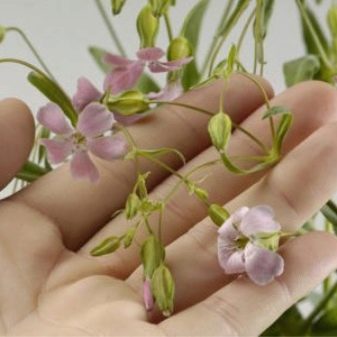

Transfer
Growing saponaria as a perennial, forces the gardener to periodically carry out anti-aging procedures. Up to 8 years old, the soapwort can not be touched, during this time it actively builds up the root and aerial parts. Then the bush is dug up and divided, seating the delenki in new places. If this is not necessary, then the surplus can be shared with neighbors or sold.
The event is held in early May, sometimes in the middle of the month.
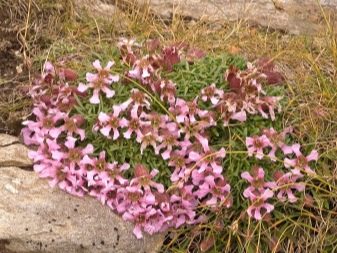

Fertilizer
Plant nutrition is very important, especially if it is cultivated as a perennial. Consequently, over time, the soil is greatly depleted, and even such an unpretentious flower will need the introduction of mineral fertilizers. In early spring, the soapwort needs phosphorus, and before planting, the soil is enriched with calcium.

Reproduction
- Sowing seeds in open ground or for seedlings.
- Delenki, when perennial uterine bushes are divided into several parts.
- Vegetatively, that is, by cuttings.
This procedure requires experience or theoretical knowledge of how to do it correctly. To do this, cut a certain number of the strongest shoots, cut off their tops and lower leaves, and plant them in neutral soil, for example, a peat-sand mixture. Before this, it is advisable to keep the cuttings in root-forming stimulants. The most popular is Kornevin.
After the roots and new leaves appear, the plants can be transplanted to a permanent place.
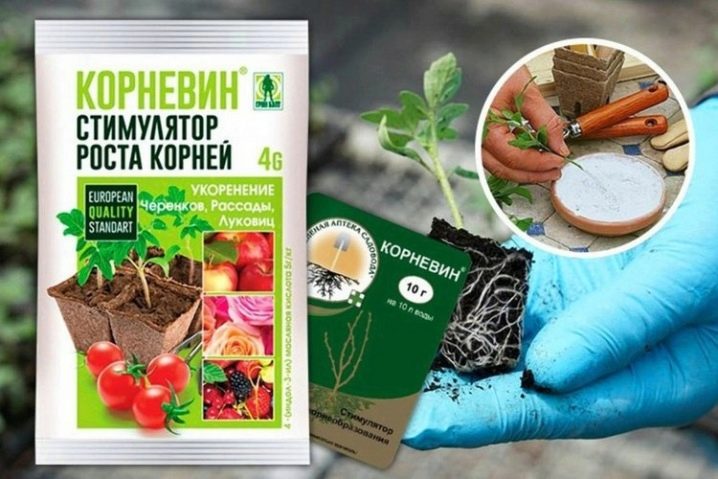
Preparing for winter
For the winter period, it is advisable to cover the soapstone with agrofibre and mulch. Without protection, only the medicinal species is able to winter. For basil-leaved saponaria, temperatures below 20 degrees are already considered critical and can lead to death.
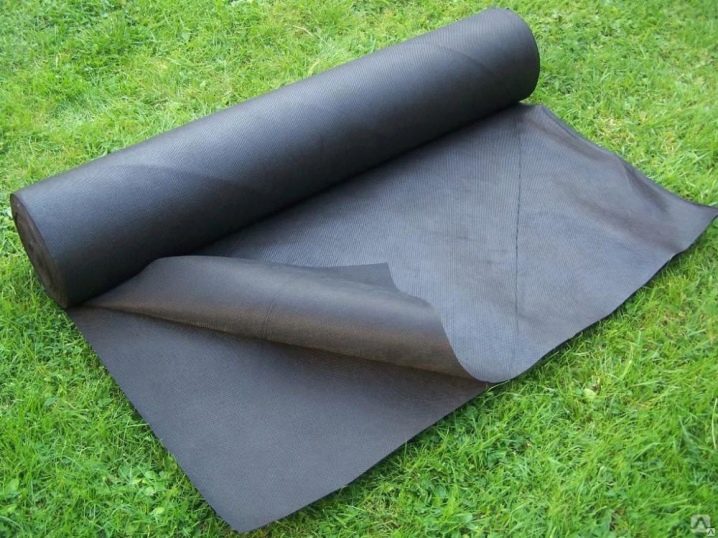
Diseases and pests
The perennial is distinguished by strong immunity and is almost not susceptible to attacks by pests and diseases of various kinds. Nevertheless, the garden scoop and its caterpillars, which, after hatching, feed on green mass, can be dangerous for him. The butterflies themselves eat the seeds while laying eggs for breeding. In the fight against such a scourge, insecticide treatments will help.
Constant waterlogging can provoke the appearance of fungal diseases: root rot, black and brown spot. In this case, Bordeaux liquid helps out well.
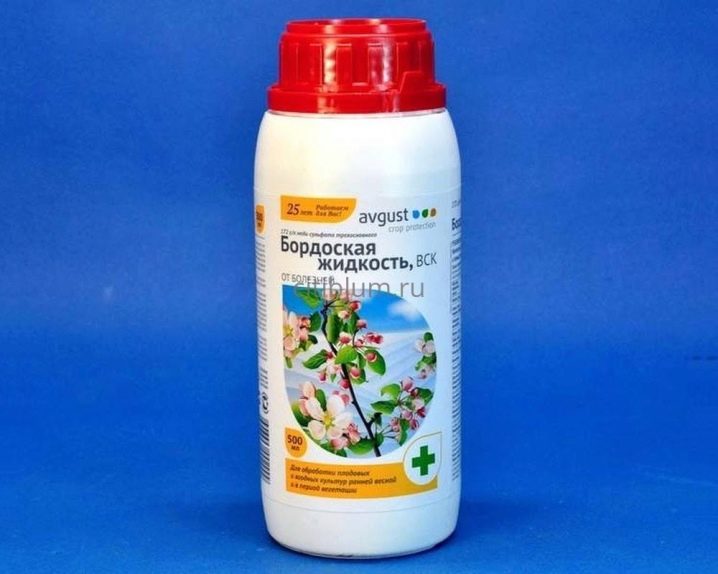
Use in landscape design
Miniature bushes with attractive and pleasant colors create stunningly beautiful carpets on alpine slides, slopes and flower beds. They look great along the paths, at the foot of such giants of the flower world as dope, dahlias, as well as tall daisies, zinnias, etc.
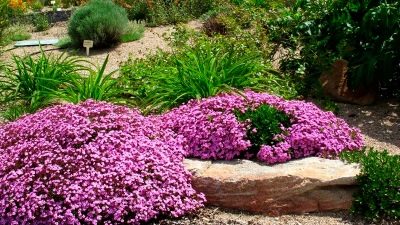
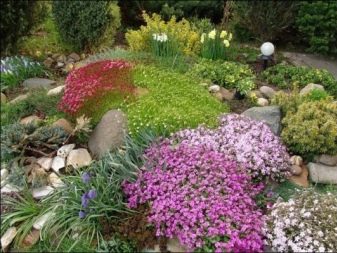








































































































The comment was sent successfully.